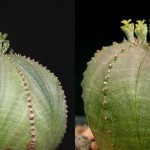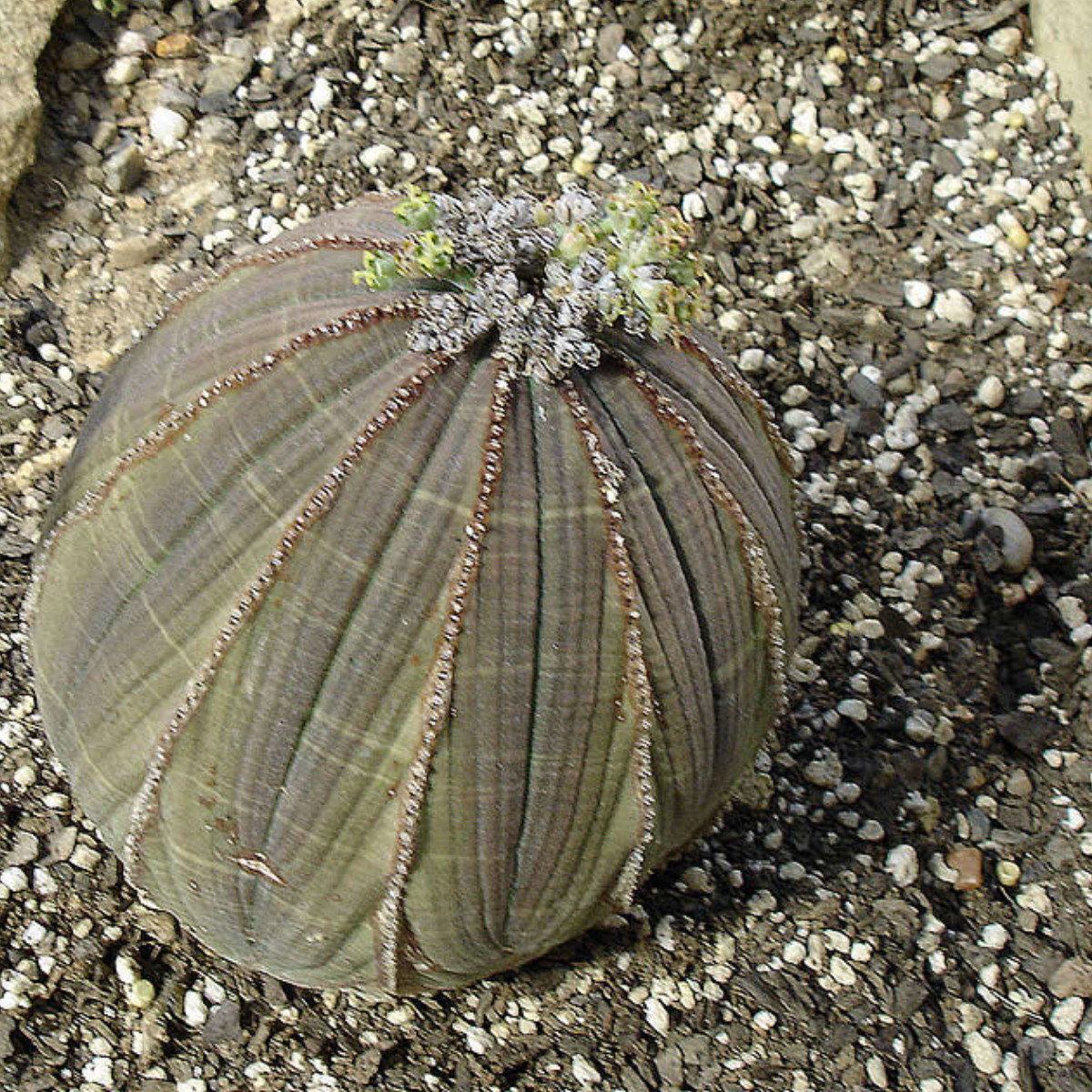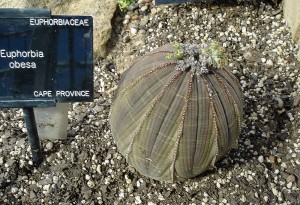Family: Euphorbiaceae
Distribution and habitat: Euphorbia obesa is a subtropical succulent species of Euphorbia genus. It comes from South Africa, especially in the Cape Province. The plant is dioecious, which means that a subject has only male or female flowers.
In the wild, it is endangered because of over-collection and poaching, because of its slow growth, and the fact that the pod contains only 2 to 3 seeds. Today it is protected by national (Nature Conservation) and international (CITES) legislation. The plants occur in karoo vegetation among Beaufort shale fragments, where they grow in full sun or in the partial shade provided by dwarf karoo shrubs. They are very well camouflaged and difficult to see. The habitat is very stony and hilly with summer rainfall, falling mainly in thunder showers. Summers are very hot: the average daily maximum about 26C (79F) and the minimum about 11C (52F). Light frost occurs during the winter months. However, it is widely cultivated in botanical gardens.
Description: Euphorbia obesa is a peculiar, almost ball shaped dwarf succulent plant that resembles a stone. It can grow to 20cm (8 inch) in height with a diameter of 9cm (3.5 inch). It is a single-stemmed, unbranched, firm-bodied plant. The stem is usually 8-angled and grooved, subglobose (almost spherical) in shape, elongating and becoming cylindrical as it gets older. Younger plants have a rounded sea urchin-like shape. The rotund stem is mottled grey-green in colour with dull purple transverse bands. It has a tapering tap root. The leaves are very rudimentary and soon drop off. All euphorbias have a complex floral arrangement that is termed a cyathium (a cup) and this is the unit of the inflorescence. A cyathium contains many highly reduced male flowers or a single female flower. In Euphorbia obesa, the cyathia appear in summer, from "circular flowering eyes", situated along the tops of the angles, near the growing tip, on the stem. They are produced on fork-branched peduncles (flower stalks), have minute bracts and are finely hairy. The cyathia are cup-shaped to 3mm (0.1 inch) in diameter, expanding in the female. The fruit is a slightly 3-angled capsule , up to 7mm (0.3 inch) in diameter that explosively releases small rounded 2mm (0.08 inch) diameter mottled grey seeds when mature. The peduncles do not persist, and fall off after the seed has been dispersed.
Houseplant care: Euphorbia obesa is a slow-growing, long-lived plant.
Sudden moves from shade into the sunlight should be avoided in order to prevent scorching.
Light:Euphorbia obesa needs full sunlight all year long. In summer, plants can moved outdoors to benefit from the increased temperatures and increased exposure to daylight. Growing the plants close to a window is usually sufficient to provide the needed light in cooler temperatures for a winter dormancy period.
Temperature: Euphorbia obesa grow best when temperatures are very warm, upper then 27-35C (81-95F), but will thrive in normal room temperatures during the active growth period (spring, summer and early autumn). While not essential, Euphorbia obesa seems to benefit from a period of winter dormancy during which the plant should be kept drier and and somewhat cooler, as this reflects the growing conditions in its habitat. At this time, it will tolerate relatively cool temperatures in the winter (tolerating temperatures as low as 10C (50F) and possibly into 4C (40F). Keep the plant totally dry in these conditions of low temperatures.
Water: During the active growth periodEuphorbia obesa should be frequently watered, allowing the soil to become dry between waterings. In mid-autumn gradually reduce the amount of water given. During the winter rest period water the plants only enough to keep the potting mixture from drying out.
Euphorbia obesa also seem to benefit from summer rains. Do not subject this plant to extended drought during the summer months, as this corresponds to their growing season and drought will prevent it from producing its annual growth.
Fertilising: Apply a week solution of liquid fertiliser about once every 6 weeks or so through the summer.
Potting and repotting: Use an equal-parts combination of soil-based potting mixture and coarse sand and perlite. Provide extra drainage by putting plenty of clay-pot fragments or other drainage material in the bottom of pots. Move plants into pots one size larger every spring; 15-20cm (6-8 inch) pots should be the biggest needed. After that, top-dressing with fresh potting mixture in the spring will be enough.
Gardening: Euphorbia obesa grown outdoors will prefer very bright conditions to partial shade in zones where the frost is not too severe. It will appreciate themorning sun. It can tolerate temperatures down to -5C to -10C (23-14F) if the roots are kept dry. It does best in a mineral soil, but is tolerant of a wide range of soil types. Good soil drainage is essential. Remove half the soil from the site and replace it with sand, blending well with the existing soil. Water sparingly during the summer months and keep dry in winter. It is a slow-growing, long-lived plant, and once established, it will be content in its position and with its soil for years. It can tolerate moderate shade and a plant that has been growing in shade should be slowly hardened off before placing it in full sun, as the plant will be severely scorched if moved too suddenly from shade into sun.
Propagation: Euphorbia obesa is easily propagated from seed sown during spring or summer. Sow in a sandy to gravel-rich, well drained potting soil in a sunny warm position and in a standard seed tray. Cover seed with a thin layer of sand (1-2mm) (0.04-0.08 inch) and keep moist. Germination occurs within 3 weeks. The seedlings have a slow to medium growth rate and can be planted out into individual pots as soon as they are large enough to handle.
Flowering can be achieved within 5-8 years. Plants can be hand pollinated with a small paint brush. Rub pollen onto the brush and transfer to stigmas of female plants. Remember to cover the female plants with a stocking or a net to catch the seeds, otherwise the capsules will shoot them far and wide.
Problems: Grown in somewhat lower light, the colourful striations will become less distinct, and the plant may have a nearly uniformly green colouration. At even lower light intensities, the growth will virtually cease or, worse still, the plant may develop etiolated growth, producing weak and leggy stems.
Do not overwater the plant to avoid roting.
Uses: Euphorbia obesa is best grown as a pot plant in a sunny position such as a window sill or verandah but can also be grown outdoors in the Karoo and other desert gardens where frost is not too severe. It does best in a gravely shale based soil, but is tolerant of a wide range of soil types. It is suitable for coastal conditions.
Drought-tolerant,Euphorbia obesa is suitable for xeriscaping.
Toxicity: As with the other Euphorbias, the sap of Euphorbia obesa is poisonous.
SUMMARY:
CHARACTERISTICS:
Foliage green
Shape globular
Height: 20cm (8 inch)
PROPER CARE:
Watering in rest period sparingly
Watering in active growth period sparingly
Light direct
Temperature in rest period min 10C max 16C (50-61F)
Temperature in active growth period min 16C max 24C (61-75F)
Humidity low
Hardiness zone: 9b-11




